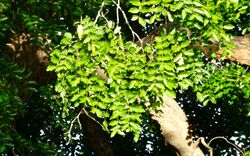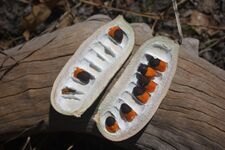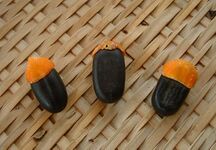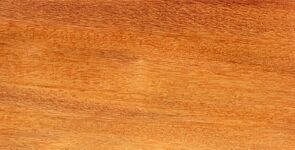Biology:Afzelia africana
| Afzelia africana | |
|---|---|

| |

| |
| Habit in Senegal, with foliage below | |
| Scientific classification | |
| Kingdom: | Plantae |
| Clade: | Tracheophytes |
| Clade: | Angiosperms |
| Clade: | Eudicots |
| Clade: | Rosids |
| Order: | Fabales |
| Family: | Fabaceae |
| Genus: | Afzelia |
| Species: | A. africana
|
| Binomial name | |
| Afzelia africana | |
Afzelia africana, the African mahogany, afzelia, lenke, lengue, apa, or doussi, is a Myrmecophyte tree species in the family Fabaceae.
Range
It occurs in Benin, Burkina Faso, Cameroon, Central African Republic, Chad, DRCongo, Ivory Coast, Ghana, Guinea, Guinea-Bissau, Mali, Niger, Nigeria, Senegal, Sierra Leone, Sudan, Togo, and Uganda.[2] It is typically found in dense, evergreen forests, but may also be found in the savanna and the coastal forests of East Africa.[3]
Description
Mature trees grow between 6 and 30 m in height. Produces white or greenish-white flowers with a red or pink stripe in panicles.[4] The flowers give way to dark brown or black shiny fruits containing poisonous black seeds attached to an edible orange aril.[5] The trunk diameter may reach 100–170 cm, sometimes more.[3] The leaves are bright green, about 30 cm long, with 7-17 pairs of elliptic or ovate leaflets.[5]
Uses
Afzelia africana was used in the Middle Ages for ship building.[6] It is one of the traditional djembe woods.[7] The building of a reconstructed 9th-century Arab merchantman, the Jewel of Muscat, required thirty-eight tons of Afzelia africana wood, which was supplied from Ghana. Curved trees were chosen for the ship's frames and timbers.[8] The trade name for the wood of this species is doussié; it is known for being resistant to decay and termites.[3]
The leaves are sometimes used as fodder for livestock.[2] The bark is often used for medicinal purposes in West Africa, and some groups regard the tree as "a refuge of invisible spirits".[9]
Gallery
References
- ↑ Hills, R. (2020). "Afzelia africana". IUCN Red List of Threatened Species 2020: e.T33032A67742420. doi:10.2305/IUCN.UK.2020-3.RLTS.T33032A67742420.en. https://www.iucnredlist.org/species/33032/67742420. Retrieved 17 November 2021.
- ↑ 2.0 2.1 "Afzelia africana (PROTA) - PlantUse English". https://uses.plantnet-project.org/en/Afzelia_africana_(PROTA).
- ↑ 3.0 3.1 3.2 "Doussié". http://www.tropicaltimber.info/specie/doussie-afzelia-africana/#lower-content.
- ↑ "Afzelia africana in Global Plants on JSTOR". https://plants.jstor.org/compilation/afzelia.africana.
- ↑ 5.0 5.1 Orwa (2009). "Afzelia africana". http://apps.worldagroforestry.org/treedb2/AFTPDFS/Afzelia_africana.PDF.
- ↑ Jackson, Robert (March–April 2012). "Sailing Through Time: Jewel of Muscat". Saudi Aramco World. http://www.saudiaramcoworld.com/issue/201203/sailing.through.time.jewel.of.muscat.htm. Retrieved 26 July 2012.
- ↑ Henning, Michi. "Djembe Woods: What You Need to Know". djembefola.com. Archived from the original on 2012-01-03. https://web.archive.org/web/20120103141203/http://djembefola.com/articles/djembe-woods.php. Retrieved 19 January 2012.
- ↑ Jewel of Muscat timeline. Accessed 2013-01-13.
- ↑ Balima, Larba Hubert; Nacoulma, Blandine Marie Ivette; Ekué, Marius Rodrigue Mensah; Kouamé, François N’Guessan; Thiombiano, Adjima (2018-03-27). "Use patterns, use values and management of Afzelia africana Sm. in Burkina Faso: implications for species domestication and sustainable conservation". Journal of Ethnobiology and Ethnomedicine 14 (1): 23. doi:10.1186/s13002-018-0221-z. ISSN 1746-4269. PMID 29587813.
External links
Wikidata ☰ Q146260 entry
 |






